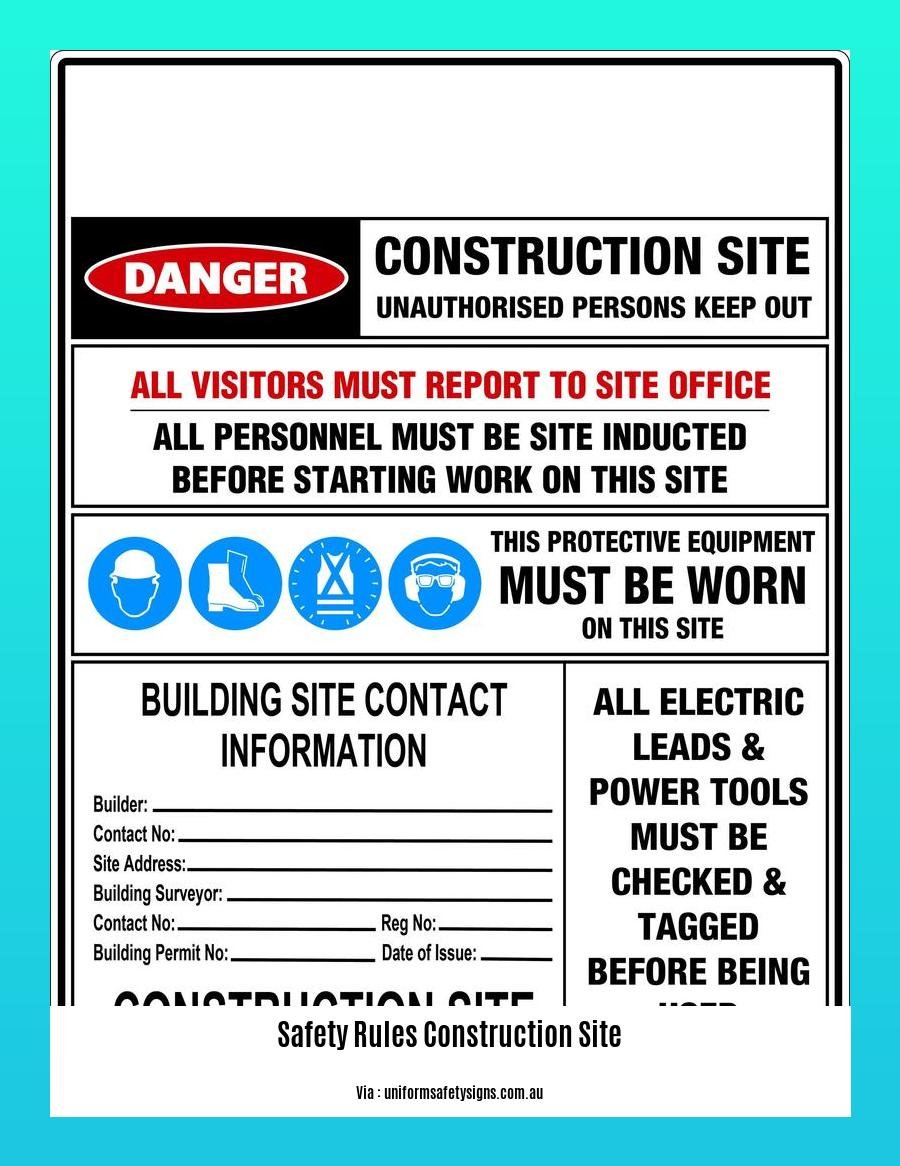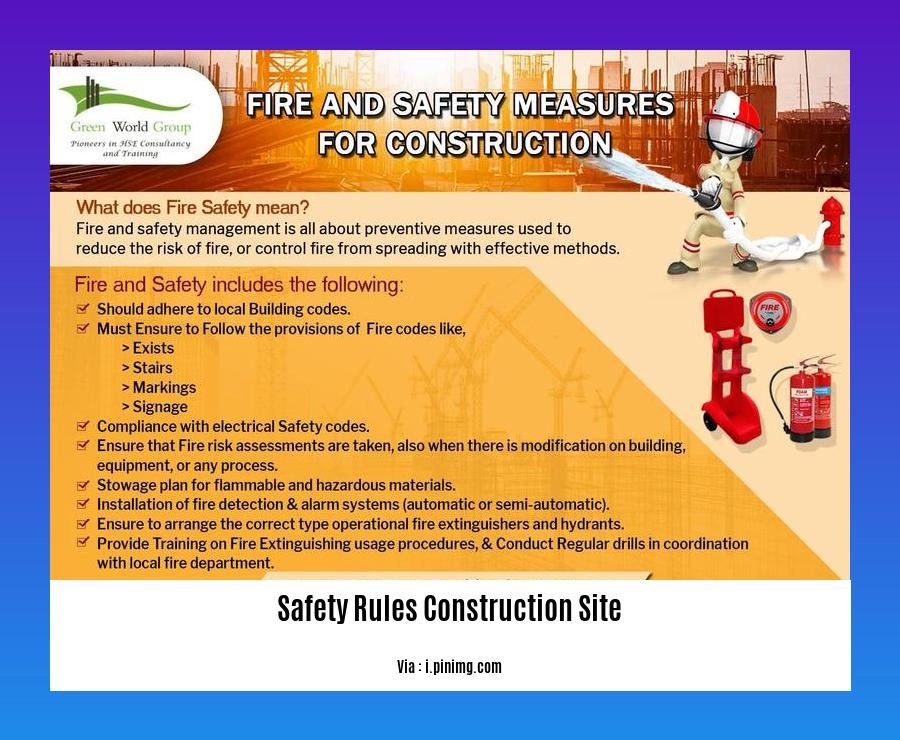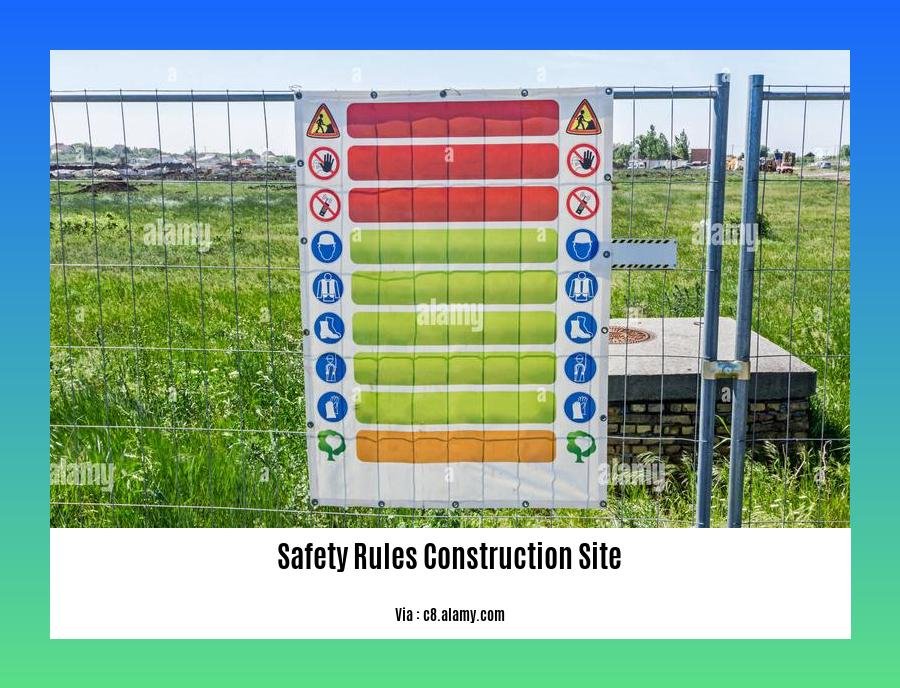Adhering to Safety Rules on Construction Sites: A Guide for Ensuring Worker Safety
Key Takeaways:
- Wear appropriate safety gear.
- Follow equipment safety guidelines.
- Keep the work area clean and organized.
- Use fall protection when working high up.
- Handle hazardous materials properly.
- Follow electrical safety rules.
- Only trained individuals should operate equipment.
- Follow safe work practices and report hazards.
- Store materials correctly.
- Report accidents and injuries promptly.
Safety Rules on Construction Sites

Any construction project can present numerous hazards to workers. It is crucial to adhere to safety rules and regulations on construction sites to prevent accidents and ensure the well-being of everyone involved.
Responsibilities of Employers and Workers
Employers are responsible for:
- Providing a safe working environment
- Identifying and assessing hazards
- Developing and implementing safety procedures
- Training workers on safety protocols
- Enforcing safety rules and regulations
Workers are responsible for:
- Following safety procedures
- Using personal protective equipment (PPE)
- Identifying and reporting hazards
- Cooperating with employers to maintain a safe work environment
Key Safety Rules
- Wear appropriate PPE: Helmets, safety glasses, gloves, and other protective gear are essential to shield workers from potential hazards.
- Follow equipment safety procedures: Operate machinery and equipment according to manufacturer instructions and receive proper training.
- Maintain a clean and organized worksite: Clutter and debris can create hazards. Regularly clean up work areas and store materials properly.
- Use fall protection measures: When working at heights, utilize guardrails, safety nets, and harnesses to prevent falls.
- Handle hazardous materials safely: Follow proper procedures for storing, using, and disposing of hazardous materials to minimize risks.
- Follow electrical safety guidelines: Ensure electrical equipment is properly grounded, inspected, and maintained to prevent electrical shocks and fires.
- Restrict access to authorized personnel: Only trained and authorized individuals should operate equipment and machinery.
- Follow safe work practices: Avoid shortcuts or practices that compromise safety. Prioritize proper lifting techniques, tool usage, and hazard recognition.
- Store and handle materials properly: Securely store materials to prevent collapse or falling objects. Use proper equipment for lifting and moving heavy items.
- Report accidents and hazards: Promptly report any incidents, injuries, or potential hazards to supervisors and safety personnel.
By adhering to these safety rules and regulations, construction sites can become safer and healthier environments for everyone involved.
For more information on the regulations and rules needed in a construction site, visit safety rules and regulations in construction site. To learn new techniques and tips about plumbing for new construction, look at rough in plumbing new construction. If you want to know more about safety regulations in building construction, check out safety rules in building construction. We also offer services for the removal of construction debris.
Safe Work Practices: A Foundation for Safe Construction Sites

As a seasoned safety expert, I’ve witnessed firsthand the importance of safe work practices in construction. These practices form the backbone of a safe and productive construction site, protecting workers and preventing incidents.
Key Takeaways:
- Wear Personal Protective Equipment (PPE): PPE includes helmets, safety glasses, earplugs, gloves, and high-visibility clothing, protecting workers from hazards like falling objects, electrical shocks, and chemical spills.
- Follow Safety Signs and Instructions: Signs provide essential warnings and guidance to navigate construction sites safely. Ignoring them can lead to serious accidents.
- Maintain a Tidy Worksite: Cluttered sites create trip and fall hazards. Keep walkways clear, remove debris regularly, and organize tools and equipment to minimize potential hazards.
- Use the Right Equipment for the Job: Using improper equipment can lead to accidents or injuries. Ensure workers have the appropriate tools and machinery for each task, and train them on their safe operation.
- Establish Emergency Response Plans: In case of an incident, a clear emergency response plan ensures everyone knows what to do and how to respond, minimizing chaos and ensuring everyone’s safety.
Citations:
– SafetyCulture: 10 Construction Safety Rules
– OSHA: Safety and Health Topics: Construction
Training and Education
Ensuring a Culture of Safety on Construction Sites Through Training and Education
Effective training and education are essential for fostering a culture of safety on construction sites. By equipping workers with the knowledge and skills to identify and mitigate hazards, we can significantly reduce the risk of accidents and injuries. Here’s how:
Comprehensive Safety Training
- Ensure that all workers receive thorough training on safety protocols, covering topics such as hazard identification, PPE usage, and emergency response procedures.
- Conduct regular refresher training sessions to reinforce knowledge and address any gaps.
- Use a combination of classroom instruction, hands-on demonstrations, and simulations to engage learners and enhance comprehension.
Specific Task Training
- Train workers on the safe operation of equipment, proper handling of materials, and any specialized tasks they may perform.
- Provide clear instructions, demonstrations, and supervision for new tasks or processes.
Continuous Education
- Stay abreast of industry best practices and new safety regulations by attending workshops, conferences, and webinars.
- Share this knowledge with workers through toolbox talks, safety bulletins, and other communication channels.
Practical Exercises and Simulations
- Conduct regular drills and simulations to test workers’ understanding and response to emergency situations.
- Use realistic scenarios to replicate potential hazards and provide workers with hands-on experience in managing them.
Key Takeaways:
- Training and education empower workers with the knowledge and skills to safeguard themselves and others.
- Comprehensive safety training covering all aspects of construction safety is crucial.
- Regular and specific task training ensures that workers are equipped to handle their responsibilities safely.
- Continuous education keeps workers informed about industry advancements and best practices.
- Practical exercises and simulations provide valuable experience and reinforce safety protocols.
Relevant URL Sources:
Emergency Preparedness and Response
As a seasoned construction safety professional, I understand the critical importance of Emergency Preparedness and Response. The inherent hazards of construction environments necessitate comprehensive plans to safeguard workers and minimize incidents. Here are some key strategies for effective Emergency Preparedness and Response:
Pre-Planning
- Establish clear emergency protocols, including designated evacuation routes, assembly points, and communication systems.
- Conduct regular safety inspections to identify and mitigate potential hazards.
- Train workers on emergency procedures and ensure they are aware of their roles and responsibilities.
- Coordinate with local emergency responders and establish response protocols.
Incident Response
- Immediately notify emergency services of any accidents or incidents.
- Follow established evacuation procedures and evacuate all non-essential personnel.
- Activate emergency response teams and delegate tasks to contain the incident and ensure safety.
- Establish a communication system to provide updates and coordinate response efforts.
Post-Incident Management
- Conduct a thorough investigation to determine the cause of the incident and identify areas for improvement.
- Provide support and counseling to affected workers.
- Review and update emergency response plans based on lessons learned.
- Implement corrective measures to prevent similar incidents from occurring in the future.
Key Takeaways:
- Emergency protocols are essential for preventing and responding to incidents effectively.
- Regular training and inspections enhance worker preparedness and reduce risks.
- Coordination with emergency responders ensures a swift and coordinated response.
- Post-incident management focuses on learning and improving emergency plans.
Relevant URL Sources:
- Emergency Preparedness and Response | Occupational Safety and Health Administration
- Principal Emergency Response and Preparedness – Occupational Safety and Health Administration
FAQ
Q1: What are the most important safety rules to follow on a construction site?
Q2: How can I ensure that my workers are following safety rules?
Q3: What are the consequences of not following safety rules on a construction site?
Q4: What are some tips for staying safe on a construction site?
Q5: What should I do if I see someone violating a safety rule on a construction site?
- Does 100% Polyester Shrink? A Complete Guide to Washing & Drying - April 16, 2025
- Elegant Drapery Solutions for Arched Windows: A Complete Guide - April 16, 2025
- The Best Dining Room Tables with Drop Leaves: A Buyer’s Guide - April 16, 2025










